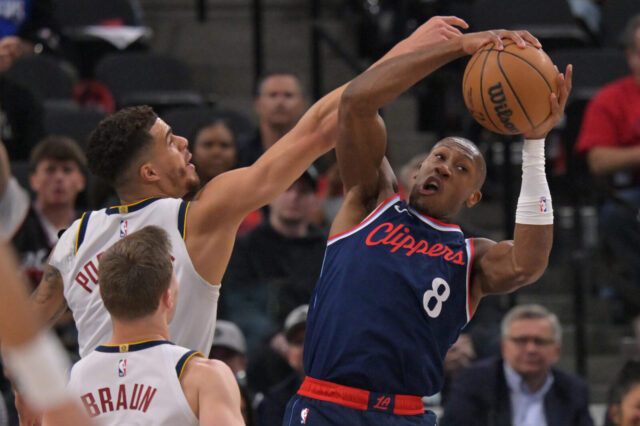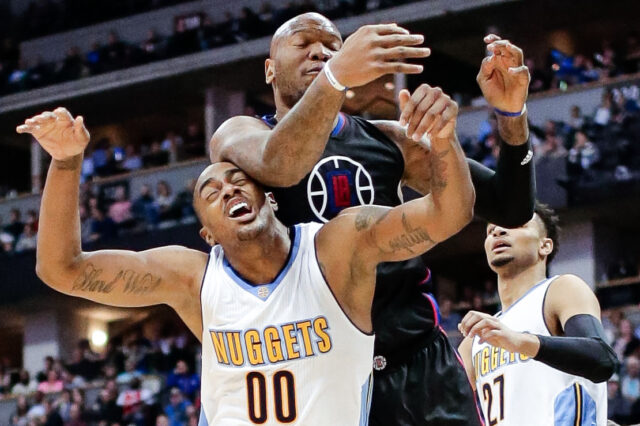If NBA teams are businesses then fans are their emotional stockholders – more loyal than regular stockholders actually, because they can’t fire anyone or change the board of directors and abandoning one team for a different one is amazingly difficult. After last night, though, the Denver Nuggets owe it to those emotional stockholders to explain the vision for the future, because right now it’s tough to discern. And without a clear vision it’s very easy to get lost along the way.
The Nuggets have one thing every non-contender is looking for: a bonafide star to build around. After identifying Jokic’s transformative talent last December, everything the Nuggets have done since should have been built around him and with the idea of putting him in the best position to become a superstar who can anchor a contender.
Instead, Denver has made a series of bewildering moves, culminating in last night’s draft selections. This is not a rant against Trey Lyles and Tyler Lydon – they are talented young men that I’m sure are looking forward to getting started in Denver and playing next to that young star in Jokic. Adam has a great podcast up on his perspective of the evening as it unfolded in the Pepsi Center. Evan has a Q&A up with Syracuse’s SBNation site that gives a nice Nikola Mirotic comp. But the questions that have to be answered are with the front office, not the players.
Here’s how I’d fill out a checklist questionnaire about Denver’s draft:
This content is no longer available.
Denver came into the draft with an overstuffed roster of similarly-talented players jockeying for position. They left it with an even worse crowding issue and no discernable plan to either get better or reduce those crowding issues. What’s the vision?
Vision is what you sell to your players to get them to buy in to all the work you want them to do, all the little details. Vision is what you sell to free agents, a plan for how to provide them with what they want while also showing them how they fit on your roster. Vision is how you rally your fanbase, flagging in recent years, by demonstrating that you know what you’re doing and your moves have a purpose.
If you have vision you can get your fans – and players – to buy into The Process and hang an ex-GM’s jersey in the rafters of a draft party that stretches into the thousands. If you can’t communicate that plan for the future you risk losing the interest of both players and fans.
Nothing is substantially different today than yesterday. Denver still has its star Nikola Jokic along with the youngsters Gary Harris, Emmanuel Mudiay, Jamal Murray, Juancho Hernangomez and Malik Beasley. What they don’t have is a clear path to 2017-18 relevancy, veterans who will be around past next year, or any experienced players who can be a clear #2 to Jokic’s #1. It’s the draft, so that’s obviously hard to get (unless you’re Minnesota, in which case you simply ask the Bulls to set their franchise on fire and hand you Jimmy Butler and they do it).
But the vision question is the nagging one after last night. The Nuggets refused to trade any of its veterans at the deadline last year, instead opting for a failed attempt at the playoffs. That choice cost them some kind of draftpick for Danilo Gallinari at the very least, as well as diminishing the value of Will Barton and Wilson Chandler (who would now be traded for only one playoff run instead of two). The thought was they might trade some during the draft but that did not happen either. So is Denver going young and staying young, or are they planning on retaining any of these veterans past this season?
After the Jusuf Nurkic trade, Tim Connelly stated that the Nuggets really didn’t have room for the Memphis pick that Denver traded for Mason Plumlee, and that Plumlee was a perfect fit next to Jokic. The next couple of months proved that fit to be rough in the short-term, while Nurkic blossomed in Portland to the chagrin of Denver fans everywhere. But Nurkic had to be moved – that’s not really the issue.
The issue is that Denver then went into the draft and added 4 players (3 domestic) that will clutter the roster further, giving lie to that reasoning. Trey Lyles and Tyler Lydon play the same position with roughly the same flaws in their game, and neither one addresses Denver’s weaknesses of defense and soft play. When the 76ers drafted 3 centers and then had to move at least one (Nerlens Noel) for a loss in pure-value terms, they did it taking what they felt to be the best player available while looking for a superstar. They found Embiid and he makes the others expendable – but if they can’t get value out of moving top-5 picks exactly how much value can Denver expect from its shuffling of pieces to locate the 8th man off the bench?
Denver’s head of scouting said that the Nuggets viewed the talent between #11 and #24 to be very similar, but instead of moving up from #13 (as Portland did from #15, using that #20 Memphis pick they got from Denver to do so) they moved back. Instead of consolidating players they added more. Instead of creating packages they are creating more roster problems.
The Nuggets have no identifiable identity to sell to free agents. Who wants to join the team that has 4 shooting guards and 6 power forwards and wait for Denver to figure it out?
They have a ton of young players and are one of just three NBA teams without a G League affiliate, so they’ll have to beg other teams to get their youngsters some much needed playing time, under a coach who is not beholden to the Nuggets or their vision in any way.
Nobody added in the draft patches any of Denver’s weaknesses, and the Nuggets front office can’t keep waving the “Jokic makes everybody better” flag forever. Not on defense he doesn’t, and since what he does improve is offense maybe you should have focused on the other side of the ball and let Jokic make up the difference with the ball in his hands.
Tim Connelly has preached patience and flexibility in the last two offseasons, but that flexibility is starting to look very reactionary. Every summer and every trade deadline the Nuggets come back with the same line about how they “made some calls” and “thought they had some deals” and “tried” but the roster stays the same. The guys who leave are the guys who agitate. If Nurkic hadn’t said anything would he still be here? Probably. Wilson Chandler made some tweets to the effect that he himself should have been more vocal about his desire to leave.
When your veterans and backups want to leave and you either cannot make trades or lose the ones you do make, that’s a bad look. There’s no point in hoarding decently-talented youth if you can neither find them playing time nor move them for value.
The Nuggets current sales pitch to its fans, its emotional stockholders, is this: “come see our nice young talent as we try desperately to figure out what to do with it and how to complement it with older players. Disclaimer: that may not happen.” Again, the 76ers have made that work so far, but the 76ers got buy-in on that vision.
How exactly the Nuggets plan to get the same is a crucial step in this rebuild. At some point the Nuggets have to build something. Unassembled bricks and lumber in a yard do not a house make. Turning pieces into one whole contender is the next step, and by retaining Arturas Karnisovas the hope was that Denver’s front office would have a complete plan that remained intact.
If they do, then they have a month or so to show that this summer. Otherwise it’s another lap around the non-competitive block with a request to check in again next draft.
I’m not sure that’s the message Denver should be sending either its fans or the league.


